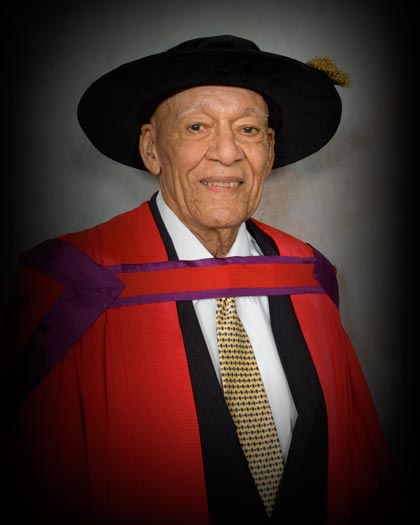Black Community Engagement Person of the Month – Lanier Phillips

The ANC is proud to introduce Persons of the Month – A virtual forum to celebrate Black achievements and history in Canada. Every month we will recognize Black people who have contributed to social justice initiatives in both Canada and throughout the world. The first spotlight focuses on Lanier Phillips.
Born on March 14, 1923 in the rural town of Lithonia, Georgia, Lanier Phillips was was an African American oceanographer and former Navy service person who left a lasting connection and impact on Newfoundland and Labrador.
Phillips grew up in a time and place of prevalent racism in America, with segregation as the established norm. Black children were prohibited from attending the same schools as white students, local government did not fund Black schools, and The Ku Klux Klan wielded their influence to keep the status quo. The experience instilled severe fear in Phillips and damaged his self-worth. He once explained this, “I saw no future, I had no dreams”.
However, in 1941 the US entered into World War II and and Phillips enlisted in the Navy at the age of eighteen. On February 18, 1942, three American ships – Truxtun, Wilkes and Pollux – sailed up the North Atlantic ocean, seemingly heading toward Newfoundland. They were under radio silence to protect their position from the threat of German U-boats in the middle of a dangerous storm. The storm would eventually cause all three vessels to hit the bottom of the waterway, becoming stuck on the rocky coastline.
Efforts to carry lifelines ashore were foiled by the storm, the cold, oil slicks, and floating wreckage. A few sailors aboard managed to overcame the odds and one scaled the cliffs to seek help from the communities of Lawn and St. Lawrence. Residents helped rescue the casualties, saving 185 of the 388 sailors aboard. The Wilkes was eventually refloated, but the Pollux and the Truxtun were wrecked. Of the forty-six 46 rescued from Truxtun, Lanier Phillips was the only Black individual.
Phillips and the other survivors were first taken to the local mine turned into a makeshift hospital by the residents of St. Lawrence. There, he found himself under the care of Violet Pike, who bathed him and worked to warm up his frozen body. Lanier explained that as a Black man, he was afraid to be in the company of a white woman. With little clothes on, he said Violet scrubbed his body to remove the black oil. He looked at her nervously and stated, “No M’am. That’s the colour of my skin”. He was the first Black person she had ever seen.
When Lanier Phillips was rescued by the residents of St. Lawrence, they treated him just as they treated the white survivors. This experience inspired him to fight racial discrimination within the US Navy. Confronting their segregation policies, he worked his way up from a Mess Attendant to become the Navy’s first black sonar technician in 1957. He would then go on to experience a successful civilian career in sonar technology.
For Phillips, the humanity shown to him by the people of St. Lawrence transformed his worldview, giving him new dreams, ambitions and self-worth. In the decades that followed, he became more involved in activism against discrimination throughout North America. He also maintained his relationship with the people of St. Lawrence, paying his last visit in 2012 to commemorate the 70th anniversary of the 1942 disaster.
In 2008, he was awarded an Honourary Doctor of Laws Degree from Memorial University of Newfoundland and Labrador, being recognized for his “resistance to and capacity to rise above repression”. Three years later, Phillips was made an honourary member of the Order of Newfoundland and Labrador (ONL) for his involvement in civil rights activism. He passed away on March 12, 2012 at the Armed Forces Retirement Home in Gulfport, Mississippi.
References
Battery Radio at http://www.batteryradio.com/Pages/Survivor.html (last accessed 26th of September, 2025)
Battery Radio, at https://www.batteryradio.com/Pages/Names.html (last accessed 26th of September, 2025)
Dead Reckoning: The Pollux-Truxtun Disaster, at https://mha.mun.ca/mha/polluxtruxtun/lanier-phillips/ (last accessed 5th of September 2025).
Dohey, Larry (2018). “Truxton and Pollux: “No m’am, that’s the colour of my skin.” Archival Moments at http://archivalmoments.ca/2018/02/truxton-and-pollux-no-mam-thats-the-colour-of-my-skin/ last accessed 26th of September 2025
Maritime History Archive (2010) Dead Reckoning: The Pollux-Truxtun Disaster at https://www.mun.ca/mha/polluxtruxtun/ack.php (last accessed 26th of September, 2025.)
Ruane, Michael E. (2010). Shipwreck survivor recalls how town altered his idea of race. Washington Post, at https://www.washingtonpost.com/wp-dyn/content/article/2010/09/15/AR2010091507189.html?nav=emailpage (last accessed 26th of September, 2025)